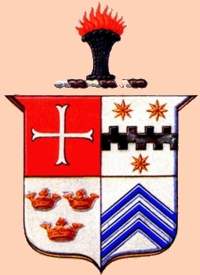Van Rensselaer

Spelled variously, the Van Rensselaer name immediately comes to mind when considering the settlement and development of the greater Albany region. Clearly the most well-known and recognizable New Netherland-era family name, at the same time, comparatively few Van Rensselaers actually meet the criteria for inclusion in our study of the people who founded and built the city of Albany.
Though small in number (probably fewer than fifty adults with the majority being Van Rensselaer women who married into mainline Albany families) , the city Van Rensselaers were uncommonly prominent in the community-based record. At the same time, any attempt to tell their story only through the lives of the city resident family members would be a serious under-representation of the Van Rensselaer contribution to the development of the early city.
As the first Europeans to "own" the land that after 1686 surrounded the city of Albany, the Van Rensselaers were responsible for recruiting and sponsoring likely emigres who would develop and safeguard their vast estate. Virtually all of the families who became Albany residents could trace their American origins to some contact with the Van Rensslear family.
From the time of the Reverend Nicholas Van Rensselaer until the mid-eighteenth century, the Van Rensselaer family home at the Elm Tree Corner was inhabited by the descendants of his widow.
In 1697, the first comprehensive census of the city of Albany described only the home of Hendrick Van Rensselaer within the city stockade. At that time, the only Van Rensselaer household configured on the census of the manor was that of his slightly older brother - the yet-unmarried patroon.
A famous yet mysterious portrait from the first half of the eighteenth century reminds us that the Van Rensselaers also were the largest slaveholders in the region.
In 1756, the census of Albany householders taken by the British army showed on the house of "Mrs. Ranslow" among the city households.
City resident Van Rensselaer men included:
Even though these individuals maintained prominent city homes, the Van Rensselaer family headquarters was the Manor House - located along the river road in what became Watervliet - about a half mile north of the city line. An additional family country seat was located across the Hudson in Greenbush.
In 1790, two Van Rensselaer-named houses were listed on the census for the city of Albany and two more in adjoining Watervliet. However, those four mansions housed a total of twenty-eight slaves and each each of them was valued at the top of their particular assessment rolls.
Stephen Van Rensselaer III (the "last" patroon) was the most notable American-born family member. With assets at the time of his death estimated at ten million dollars, in 2007 Fortune Magazine named him the tenth richest American of all time. However, he assumed the title "Lord of the Manor" on his twenty-first birthday and never really lived in the city - although he held buildings and properties in Albany and beyond. His contemporary and aide, Solomon Van Rensselaer, was a more representative early Albany family member.
The Van Rensselaer family played a major part in the settlement and development of Rensselaerswyck, Castle Island, Bethlehem!
Modern depictation of what "they" say is the first Kiliaen Van Rensselaer's coat of arms adapted from the RPI website.
Some Van Rensselaer women who married and raised families in the city of Albany:
or why the Van Rensselaers were unlike all the other early Albany people
t Because of KVR I, they were the most advantaged
t Owned all the land first and well before and settlement of the business and residence center that became Albany
land ownership trumps fur trade
landholding occupied most family members for almost two centuries
t Few actual Van Rensselaers spread across great holdings - one city house
t Elite marriages only
The most promising hope for establishing the Van Rensselaer name in the city of Albany died at age forty-two.
This outline material was used in conjunction with a public program on the Albany Van Rensselaers presented on April 23, 2009 on behalf of the Friends of the New York State Library.
first posted: 4/10/09